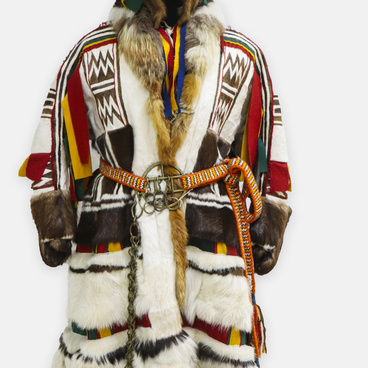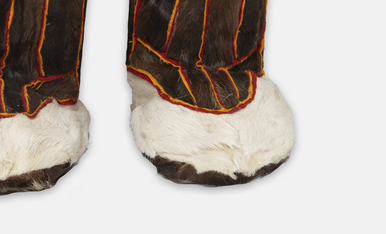Nenets national clothing has developed over thousands of years. The cut has changed slightly, but the material and decorative patterns have remained unchanged. The design of Nenets clothes is influenced by two main factors — the harsh climate of the Arctic Circle and the nomadic lifestyle of reindeer herders.
According to tradition, clothing had a single, commonly accepted cut, which all women had to adhere to. The designs were passed down from generation to generation, and girls were taught to sew from the age of five. It was the main craft of Nenets women: a woman was supposed to saw by hand not only all kinds of clothing for her family but also shoes and the walls of her portable house — the chum.
Many Nenets tales feature a saying according to which a person who has a set of clothes is well-situated, and a person who has two lives happily, while those who freeze in the cold are truly unfortunate. Clothes protect the Nenets from severe frost and wind in winter and from annoying insects in summer.
In the old days, the Nenets made all their clothes from deer hides. Nowadays, hides and furs are reserved only for outerwear. A panitsa is a type of women’s winter outerwear. Unlike the men’s malitsa, it has a front opening, decorated with strips of white and dark fur, as well as inserts of colored cloth.
A panitsa has two layers, sewn with fur outside and inside. It has a front opening and front panels which are fastened using leather straps. The wearer ties the straps from the inside by pulling the arms out of the wide holes of the sleeves. A panitsa is usually worn with a belt which is woven from colorful threads and folded in two. A copper buckle in the shape of a ring is sewn near one of the ends.
Panitsas are sewn horizontally and vertically from
the skins of beaver, fox, dog, Arctic fox, and reindeer. The Nenets Museum of Local
Lore houses a panitsa of the Bolshezemelsky type, cut vertically, made entirely
of reindeer fur. The back of the panitsa consists of three parts, with the
middle one made of a different color. Women often decorate their panitsas with
fur mosaics made of contrasting pieces of fur cut according to a pattern and
sewn together to form a single decorative image.




